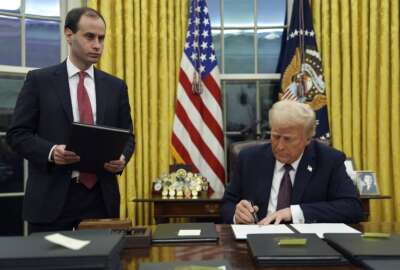Trump’s executive order directs NORTHCOM to ‘seal’ the border
The executive order requires the command to deliver both a contingency and campaign plan to "provide steady-state southern border security."
A new executive order from President Donald Trump tasks the U.S. Northern Command to secure America’s borders as part of his major political promise to crack down on immigration.
The order first directs the defense secretary to assign NORTHCOM the mission to “seal the borders and maintain the sovereignty, territorial integrity, and security of the United States by repelling forms of invasion including unlawful mass migration, narcotics trafficking, human smuggling and trafficking, and other criminal activities.”
Robert Salesses, who is currently serving as acting defense secretary until Trump’s nominee for the role, Pete Hegseth, is confirmed by Congress, has 10 days to provide a revised unified command plan to the president.
The directive also orders NORTHCOM to develop a level 3 contingency plan — such documents address emergencies that require significant coordination and resource allocation.
Gen. Gregory Guillot, who leads NORTHCOM, has 30 days to prepare a plan that lays out just how the command will go about “sealing” the border.
In addition to the level 3 contingency plan, the executive order also directs NORTHCOM to devise a campaign plan, which, unlike contingency plans, focuses on long-term strategy. It also directs the DoD to provide “continuous assessments of all available options to protect the sovereign territory of the United States from mass unlawful entry.”
NORTHCOM is primarily responsible for homeland defense and civil support within the North American continent. It assists civilian agencies, including the Department of Homeland Security and the Federal Emergency Management Agency, during natural disasters. Its mission also includes counter-drug operations.
Along with the North American Aerospace Defense Command (NORAD), NORTHCOM is responsible for air and missile warning, airspace control and maritime warning.
The command doesn’t have permanent forces — it relies on temporarily assigned forces from the military services when needed for a specific mission. Tasking NORTHCOM with a mission of “sealing” the border would require the Defense Department to pull forces from the service branches or combatant commands.
When it comes to civil support, NORTHCOM uses joint task forces that step in when emergencies exceed the capabilities of civilian agencies. The command’s support in these instances is limited.
While the executive order directs NORTHCOM to have a contingency and a campaign plan, it doesn’t mention providing civil support to agencies such as the DHS, noted Elizabeth Goitein, the senior director of the Brennan Center’s Liberty and National Security Program.
“The order relies on the president’s commander in chief authority, uses the phrase “repel the invasion,” and directs the secretary of defense to implement a “campaign planning requirement.” This is the language of military operations, not support to law enforcement,” Goitein wrote on the social platform X.
“In this executive order, Trump seems to be bypassing the Insurrection Act and going straight to the president’s inherent constitutional authority to repel foreign invasions—with enormous implications for the use of force, cross-border operations, detention authority, etc.“
Goitein said the order, however, may face legal challenges given its description of the border situation as an “invasion.”
“Many of the orders Trump issued yesterday are poorly drafted and seem to be more about sending a message than generating specific action. For instance, at least one order directs the Secretary of Homeland Security to “repel the invasion” at the border. Civilian officials don’t repel invasions; they enforce laws,” said Goitein.
“I spoke to a military expert who said the NORTHCOM order is also highly irregular. NORTHCOM’s resolution of these issues might be a “campaign” that focuses on providing logistical support to DHS—basically harmonizing this order with other orders that quite clearly treat unlawful migration as remaining in the purview of civilian agencies.”
The U.S. Coast Guard also said Tuesday night that it would surge its assets to the southeast and southwest borders, along with other areas of the country to “detect, deter and interdict illegal migration, drug smuggling and other terrorist or hostile activity.”
Copyright © 2025 Federal News Network. All rights reserved. This website is not intended for users located within the European Economic Area.







